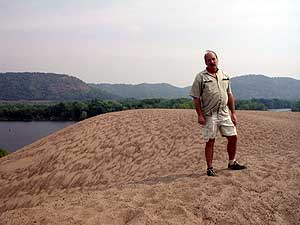|
Audio
Photos
More from MPR
Resources
Your Voice
|
The fight for Island 42
October 3, 2003
The U.S. Army Corps of Engineers has begun removing more than 1 million cubic yards of sand from an island in the Mississippi River south of Wabasha. The $4 million project aims to reduce the size of what's known as Island 42 to help ease barge passage on the river. The project has attracted criticism from scientists who say Island 42 is a crucial nesting spot for a number of threatened species of turtles.
Weaver Bottoms, Minn. — This sandy, windswept island is a desolate place. It's hardly eye-catching. It doesn't have a name -- it has a number. But that doesn't stop Mike Pappas from nicknaming Island 42 the "Taj Mahal" of turtle nesting.
 | |||
"In this pool, this is the absolute best place for the turtles to nest and have the chance to survive," says Pappas.
Pappas's feet sink as he walks up the steep face of the sand dune which makes up most of Island 42.
He's here to complete a study examining the island's importance as a nesting spot for seven threatened species of turtles. Preliminary results show this year, more than 600 female turtles laid more than 10,000 eggs on the island. That's much more than what he and other river experts expected.
Pappas doesn't expect similar results next year. The Army Corps of Engineers is about to move much of the island and make it into a recreation area for boaters. Pappas says when turtles come back here next summer to nest, they'll be in for a nasty surprise.
"This whole inner portion you're looking at will become water. It will be 30 feet deep in here. Can you imagine the amount of boats that will come here?" says Pappas. "The critical point is the turtles will probably come back here and nest, and the success ratio will probably go down because there will be less area, higher predation, more damage from boats."
 | |||
Pappas starts the motor in his boat and manuevers it around the three-block-long island. Just around the corner, the Army Corps' equipment towers over the island.
A crew with a tugboat and a crane is welding together what will be a three-mile pipeline. It will act as a huge vacuum cleaner that will suck 1.3 million cubic yards of sand from Island 42 and deposit it on shore over a 40-acre abandoned farm field.
Pappas says the money for this project would have been better spent depositing the sand downstream along an area called the Weaver Bottoms. This way, he says, it could give turtles an alternate nesting area. It would also help a wetland that is quickly vanishing as a result of flooding caused by the river's lock and dam system.
 | |||
"We have all this wonderful sand that we can use to create habitat, and we're doing just the opposite. We're going to pump it up on condemned farm fields instead of making habitat," says Pappas.
Pappas says this project is proof that the Corps is more interested in serving the needs of the barge industry than it is in protecting the river's ecosystem.
Kurt Brownell, a natural resources specialist with the Army Corps of Engineers, helped plan the Island 42 project.
He says the Corps didn't know about the scale of turtle nesting on the island until recently, when Pappas brought up the issue. He says the Island 42 project has been in the works for years, and altering it now would cost too much money.
|
We have all this wonderful sand that we can use to create habitat, and we're doing just the opposite. We're going to pump it up on condemned farm fields instead of making habitat.
- Turtle researcher Mike Pappas |
Plus, he says, despite Pappas' research, there is no scientific proof addressing the island's importance for the survival of turtles.
"While there may be documented eggs that have been found on this island, there really hasn't been any scientific study on what the hatching success is. Even in good areas, sometimes you can get 100 percent nesting mortality," says Brownell.
Both Pappas and his colleague, turtle expert Justin Congdon of the University of Georgia, counter that if what the Corps's Brownell says is true, then female turtles would most likely not be coming back each year to Island 42 to nest.
The Corps's Brownell says if Pappas's study proves that the island is important to the survival of turtles in this area, then the plans for the island may change.
"If the study shows that this is a really good nesting island and there's really good hatchability, and we don't get a lot of predation, and that recreation is negatively impacting it, then that certainly will be open to discussion with other agencies on how to best manage that," says Brownell.
Plus, says Brownell, the Corps has plans to draw down the pool that contains the Weaver Bottoms in 2005. He says the Corps has plans to build more islands in the bottoms with the sand they remove from the river's main channel, giving turtles more sandy islands where they can return to lay their eggs.
|
News Headlines
|
Related Subjects
|

